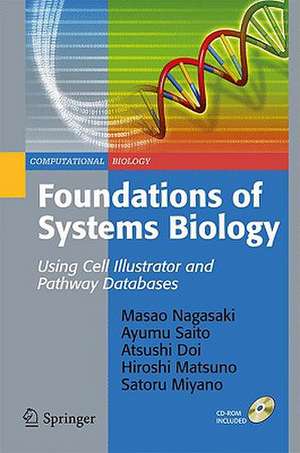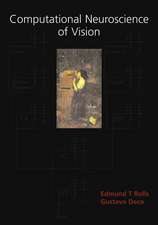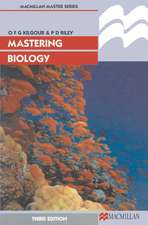Foundations of Systems Biology: Using Cell Illustrator and Pathway Databases: Computational Biology, cartea 13
Autor Masao Nagasaki, Ayumu Saito, Atsushi Doi, Hiroshi Matsuno, Satoru Miyanoen Limba Engleză Mixed media product – 6 apr 2009
| Toate formatele și edițiile | Preț | Express |
|---|---|---|
| Paperback (1) | 314.41 lei 6-8 săpt. | |
| SPRINGER LONDON – 30 apr 2017 | 314.41 lei 6-8 săpt. | |
| Mixed media product (1) | 322.31 lei 6-8 săpt. | |
| SPRINGER LONDON – 6 apr 2009 | 322.31 lei 6-8 săpt. |
Din seria Computational Biology
- 20%
 Preț: 539.14 lei
Preț: 539.14 lei - 15%
 Preț: 645.60 lei
Preț: 645.60 lei - 15%
 Preț: 633.68 lei
Preț: 633.68 lei - 20%
 Preț: 637.06 lei
Preț: 637.06 lei - 5%
 Preț: 1434.18 lei
Preț: 1434.18 lei - 18%
 Preț: 945.79 lei
Preț: 945.79 lei - 18%
 Preț: 945.13 lei
Preț: 945.13 lei - 15%
 Preț: 644.95 lei
Preț: 644.95 lei -
 Preț: 447.56 lei
Preț: 447.56 lei - 15%
 Preț: 643.65 lei
Preț: 643.65 lei - 15%
 Preț: 648.89 lei
Preț: 648.89 lei - 18%
 Preț: 900.80 lei
Preț: 900.80 lei - 15%
 Preț: 653.14 lei
Preț: 653.14 lei -
 Preț: 400.85 lei
Preț: 400.85 lei - 15%
 Preț: 696.50 lei
Preț: 696.50 lei -
 Preț: 387.96 lei
Preț: 387.96 lei - 15%
 Preț: 645.79 lei
Preț: 645.79 lei - 20%
 Preț: 560.67 lei
Preț: 560.67 lei - 15%
 Preț: 653.65 lei
Preț: 653.65 lei - 15%
 Preț: 638.57 lei
Preț: 638.57 lei - 20%
 Preț: 575.99 lei
Preț: 575.99 lei - 18%
 Preț: 1112.15 lei
Preț: 1112.15 lei - 18%
 Preț: 785.42 lei
Preț: 785.42 lei - 20%
 Preț: 1047.22 lei
Preț: 1047.22 lei - 18%
 Preț: 1230.84 lei
Preț: 1230.84 lei
Preț: 322.31 lei
Nou
Puncte Express: 483
Preț estimativ în valută:
61.67€ • 64.39$ • 51.04£
61.67€ • 64.39$ • 51.04£
Carte tipărită la comandă
Livrare economică 04-18 aprilie
Preluare comenzi: 021 569.72.76
Specificații
ISBN-13: 9781848820227
ISBN-10: 1848820224
Pagini: 168
Ilustrații: XII, 155 p. With CD-ROM.
Dimensiuni: 155 x 235 x 14 mm
Greutate: 0.43 kg
Ediția:2009
Editura: SPRINGER LONDON
Colecția Springer
Seria Computational Biology
Locul publicării:London, United Kingdom
ISBN-10: 1848820224
Pagini: 168
Ilustrații: XII, 155 p. With CD-ROM.
Dimensiuni: 155 x 235 x 14 mm
Greutate: 0.43 kg
Ediția:2009
Editura: SPRINGER LONDON
Colecția Springer
Seria Computational Biology
Locul publicării:London, United Kingdom
Public țintă
Lower undergraduateCuprins
Pathway Databases.- Pathway Simulation Software.- Starting Cell Illustrator.- Pathway Modeling and Simulation.- Computational Platform for Systems Biology.
Textul de pe ultima copertă
Navigating safely through a wealth of genome, protein and metabolite information, as well as a host of information processing tools, without getting lost is crucial for successful research in – and teaching of - molecular biology.
This concise, easy-to-follow textbook/guide serves as a valuable introduction to contemporary cell biology for readers and offers insight into the key research directions in the field. It begins with an overview of existing tools for finding, designing and investigating metabolic, genetic, signalling and other network databases. This practical guide then introduces Cell Illustrator®, a software tool for biological pathway modelling and simulation, developed by the authors. In-depth discussion reveals how this tool can be used for creating, analyzing and simulating biological models, thereby explicating and testing current understanding of basic biological processes. Readers do not require prior knowledge of differential equations or programming.
Features:
• Provides many helpful learning aids, such as detailed examples throughout, and exercises and solutions
• Designed and structured to be part of a semester-long course
• Discusses the computational functionalities required for Systems Biology
• Addresses practical issues surrounding software tools
• Introduces the current big bio-databases such as TRANSPATH® by Biobase, and explains why and how they can be used to develop and support systems biology research
• Explains important pathway databases and software tools, together with their related concepts
• Guides the reader to model pathways in a step-by-step and clear manner
• Contains a Foreword written by Professor Andreas Dress, Director CAS-MPG Partner Institute for Computational Biology, Shanghai Institutes for Biological Sciences, Chinese Academy of Sciences
Written for undergraduates, this reader-friendly introduction to the field of Systems Biologyoffers insight and teaches sound expertise in the subject. It will also prove valuable to graduate students and professionals wishing to develop and support their systems-biology research.
This concise, easy-to-follow textbook/guide serves as a valuable introduction to contemporary cell biology for readers and offers insight into the key research directions in the field. It begins with an overview of existing tools for finding, designing and investigating metabolic, genetic, signalling and other network databases. This practical guide then introduces Cell Illustrator®, a software tool for biological pathway modelling and simulation, developed by the authors. In-depth discussion reveals how this tool can be used for creating, analyzing and simulating biological models, thereby explicating and testing current understanding of basic biological processes. Readers do not require prior knowledge of differential equations or programming.
Features:
• Provides many helpful learning aids, such as detailed examples throughout, and exercises and solutions
• Designed and structured to be part of a semester-long course
• Discusses the computational functionalities required for Systems Biology
• Addresses practical issues surrounding software tools
• Introduces the current big bio-databases such as TRANSPATH® by Biobase, and explains why and how they can be used to develop and support systems biology research
• Explains important pathway databases and software tools, together with their related concepts
• Guides the reader to model pathways in a step-by-step and clear manner
• Contains a Foreword written by Professor Andreas Dress, Director CAS-MPG Partner Institute for Computational Biology, Shanghai Institutes for Biological Sciences, Chinese Academy of Sciences
Written for undergraduates, this reader-friendly introduction to the field of Systems Biologyoffers insight and teaches sound expertise in the subject. It will also prove valuable to graduate students and professionals wishing to develop and support their systems-biology research.
Caracteristici
A concise, easy-to-follow text, serving as a valuable introduction to contemporary cell biology and offering insight into the key research directions in the field Introduces the current big bio-databases, and why and how they can be used to develop and support systems biology research Includes supplementary material: sn.pub/extras



















